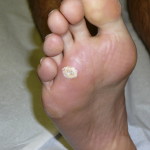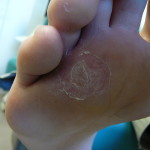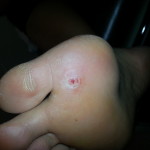Plantars Wart
Plantars wart. The pain on the bottom of your foot is getting really uncomfortable. You have tried callus removers and decided its not a callus. So playing doctor online seems like your next choice and you have come to the decision that it is a wart. First thing you are wondering is how did i get this. First of all it is called a verruca Plantaris. Next don’t worry you are not alone 7-10 percent of the USA population is infected with it. It is a virus from the human papilloma virus family. Also your genes play a role if you are predisposed to getting this virus. The virus enters your skin through contact and possibly through very tiny cuts in your skin on the bottom of your foot. They are microscopic in size and could be anywhere from the floor of your house to a public shower in your gym. You can be the cleanest person in the world , it’s impossible to prevent getting a plantars wart. If you’re gonna get it you’re gonna get it. It can take a week to a few months till you see it. The warts typically are different than corns and calluses because corns and calluses are on bony prominences and weight bearing surfaces. Warts are not. Also if you squeeze a wart from side to side it is painful, corns are not. Corns are painful on direct pressure. with warts you will see many times little black dots under the lesion. Also they will have many times a cauliflower appearance when a few are clustered together. There are some studies that show you can spread them to other sites of your body when you touch them. There are many studies that show long time warts can turn into cancers, such as Verrucous carcinoma.
There are many described treatments. Salicylic acid is the most common. By applying this acid it creates a chemical environment that they don’t survive in. Also there is freezing the wart , we use a liquid nitrogen to freeze them to death. If that is not successful we can inject the wart with Bleomycin, which can kill the wart. There are lasers available that i use in an operating room such as a CO2 laser. And lastly is to cut them out and stitch up the skin- that is the guaranteed one stop method. But requires surgery and anesthesia, and being off your foot for a few weeks until the incision heals.
Feel free to email us with any questions.
- Plantars wart
- plantars wart
- Plantars wart
- foot callus




